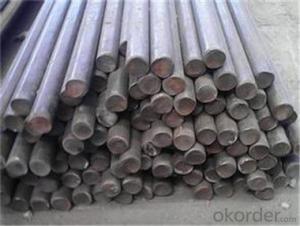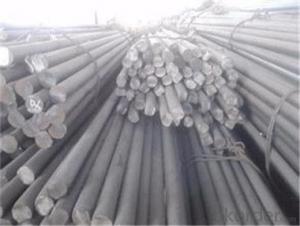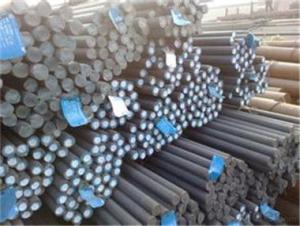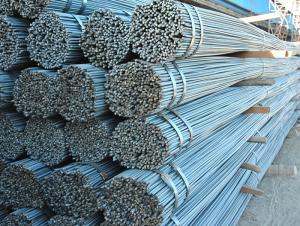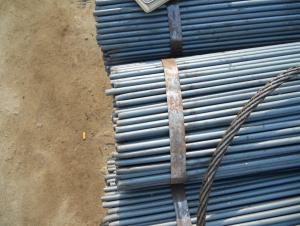Hot Rolled 12mm Steel Rod Price Steel Bar CNBM
- Loading Port:
- Tianjin
- Payment Terms:
- TT OR LC
- Min Order Qty:
- 334 m.t.
- Supply Capability:
- 2000000 m.t./month
OKorder Service Pledge
OKorder Financial Service
You Might Also Like
Description of steel round bar:
(1) Thickness of not more than 2MM sheet, efficient blanking die, punch die and pressure die etc.
(2) All kinds of scissors, inserts, woodworking blade.
(3) Thread rolling die and wear-resistant slider.
Festures of steel round bar:
4340 Forged Round Steel Bar
1.Dia 80-800mm Length:2000-13000mm or as required
2.Technique:Forged
3.Delivery Time:45 days
Specifications of steel round bar:
It is used in the manufacture of a higher strength and higher quenching and tempering section of the 35CrMo steel, like big locomotive traction gears, supercharger drive gear, rear axle, the connecting rod and the spring load greatly clip.
Round bar | Diameter(mm) | Length (mm) | |
10~800 | 2000~5800 | ||
plate/sheet | Thickness(mm) | Width (mm) | Length (mm) |
10~800 | 80~2300 | 2000~5800
|
Images of steel round bar:
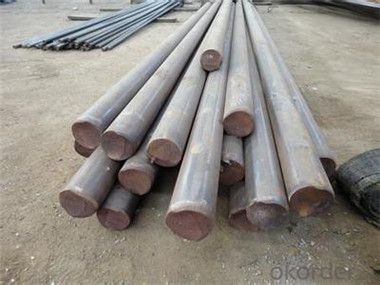
FAQ:
1. What is your package?
Packing situation: standard seaworthy packing or as customer required.
2. How long is the lead time?
Delivery time: 45 days after order confirmed.
3. What payment term do you accept?
Payment: T/T or L/C at sight.
- Q:Can steel round bars be used for making decorative items?
- Yes, steel round bars can be used for making decorative items. Steel round bars can be bent, shaped, and welded to create unique and decorative designs. The durability and strength of steel make it a suitable material for creating various decorative items such as sculptures, furniture, and architectural elements.
- Q:Can steel round bars be used for making exhaust systems?
- Yes, steel round bars can be used for making exhaust systems. Steel is a commonly used material for exhaust systems due to its durability, heat resistance, and cost-effectiveness. Steel round bars can be shaped and welded to create the necessary components for an exhaust system, such as pipes and mufflers. However, it is important to consider the specific requirements and regulations for exhaust systems in terms of material composition and performance.
- Q:How do steel round bars compare to stainless steel round bars?
- Steel round bars and stainless steel round bars differ in their composition, making them suitable for various applications. The composition of steel mainly consists of iron with small amounts of carbon and other elements, whereas stainless steel is an alloy composed of iron, chromium, and often other elements like nickel or molybdenum. This unique composition gives stainless steel its distinctive properties, such as corrosion resistance. Both steel and stainless steel round bars can be manufactured to have high tensile strength. However, stainless steel generally has higher tensile strength compared to regular steel, making it more suitable for applications requiring additional strength and durability. Another significant difference lies in their resistance to corrosion. Stainless steel round bars have excellent corrosion resistance due to the presence of chromium in their composition, making them ideal for applications exposed to moisture, chemicals, or other corrosive environments. On the other hand, steel round bars are more prone to rust and corrosion and may need additional protective coatings in such environments. In terms of cost, steel round bars are generally more affordable compared to stainless steel round bars. The higher cost of stainless steel is attributed to its unique properties and the additional alloying elements required in its production. Both steel and stainless steel round bars have advantages and specific applications. Steel round bars are commonly used in construction, manufacturing, and general-purpose applications where corrosion resistance is not a primary concern. In contrast, stainless steel round bars find extensive use in industries such as food processing, chemical processing, medical equipment, and marine applications where corrosion resistance is crucial. In conclusion, the choice between steel round bars and stainless steel round bars depends on the specific requirements of the application. Steel round bars are more cost-effective but may require additional corrosion protection, while stainless steel round bars offer superior corrosion resistance and strength.
- Q:What are the advantages of using heat-resistant steel round bars?
- Heat-resistant steel round bars have several advantages. Firstly, they are designed specifically to maintain their mechanical properties even in high temperatures. This means they can remain strong and structurally sound in extreme heat conditions. Secondly, these round bars have exceptional resistance to corrosion. This makes them highly durable and suitable for environments where they may come into contact with corrosive substances or chemicals. Their resistance to corrosion ensures a longer lifespan and reduces the need for frequent maintenance or replacement. Additionally, heat-resistant steel round bars have superior thermal conductivity. This allows them to efficiently transfer heat, which is beneficial in industries like power generation or petrochemicals where heat transfer is crucial. Using heat-resistant steel round bars guarantees optimal performance and energy efficiency. Furthermore, these round bars offer excellent dimensional stability. Even when exposed to high temperatures, they retain their shape and size without warping or deforming. This is particularly important in applications that require precise measurements and tight tolerances. Lastly, heat-resistant steel round bars come in various sizes and grades, offering versatility in their applications. They can be used in industries such as aerospace, automotive, construction, and manufacturing, where high temperatures are involved. In conclusion, the advantages of using heat-resistant steel round bars include their ability to withstand high temperatures, resistance to corrosion, superior thermal conductivity, dimensional stability, and versatility in applications. These benefits make them an ideal choice for industries that require materials to perform reliably under extreme heat conditions.
- Q:What are the different heat treatment methods for steel round bars?
- There are several heat treatment methods that are commonly used for steel round bars to enhance their mechanical properties and improve their overall performance. These methods include annealing, normalizing, quenching, tempering, and case hardening. 1. Annealing: This heat treatment process involves heating the steel round bars to a specific temperature and holding it there for a certain amount of time to achieve a uniform microstructure. Annealing helps to relieve internal stresses, increase ductility, and improve machinability. 2. Normalizing: In this method, the steel round bars are heated to a temperature slightly above their critical transformation temperature and then cooled in still air. Normalizing refines the grain structure of the steel, improves its mechanical properties, and enhances its resistance to impact and fatigue. 3. Quenching: Quenching involves heating the steel round bars to a temperature above its critical temperature and then rapidly cooling it by immersing it in a quenching medium such as oil, water, or brine. This rapid cooling hardens the steel, making it stronger and more resistant to wear and abrasion. However, quenched steel can be brittle, so additional heat treatment steps may be required. 4. Tempering: After the quenching process, the steel round bars are often tempered to reduce brittleness and improve toughness. Tempering involves reheating the quenched steel to a specific temperature and holding it there for a specific time, followed by slow cooling. This process helps to reduce internal stresses, increase ductility, and improve the steel's overall toughness and machinability. 5. Case Hardening: Case hardening is a surface heat treatment method used to increase the hardness of the outer layer of the steel round bars while maintaining a relatively softer core. This process involves heating the steel in a carbon-rich environment, such as a gas or salt bath, and then quenching it to achieve a hardened outer layer. Case hardening improves wear resistance and fatigue strength, making the steel suitable for applications where high surface hardness is required. It's important to note that the specific heat treatment method used for steel round bars depends on the desired mechanical properties and the intended application of the product. Manufacturers carefully select the appropriate heat treatment method based on factors such as the composition of the steel, the desired hardness, and the required strength.
- Q:What is the maximum elongation of steel round bars?
- The maximum elongation of steel round bars can vary depending on the specific grade and composition of the steel. However, in general, the maximum elongation for steel round bars is typically around 20-30% of its original length. This means that the steel round bar can stretch or elongate by up to 20-30% before reaching its breaking point or ultimate tensile strength. It is important to note that this maximum elongation is influenced by various factors such as the quality of the steel, the manufacturing process, and any heat treatment applied to the bars. Therefore, it is advisable to consult the specific manufacturer's specifications and consider the intended application of the steel round bars to determine the maximum elongation for a particular case.
- Q:What are the different welding techniques for steel round bars?
- There are several different welding techniques that can be used for steel round bars, including shielded metal arc welding (SMAW), gas metal arc welding (GMAW), gas tungsten arc welding (GTAW), and flux-cored arc welding (FCAW). Each technique has its own advantages and disadvantages, depending on factors such as the thickness of the steel, the desired weld strength, and the specific application.
- Q:How do steel round bars compare to fiberglass or composite bars?
- Steel round bars are generally stronger and more durable than fiberglass or composite bars. They have a higher tensile strength, making them suitable for heavy-duty applications and environments that require resistance to extreme conditions. Fiberglass or composite bars, on the other hand, are lighter in weight and have better corrosion resistance, making them suitable for applications like construction and transportation, where weight reduction and resistance to chemicals or moisture are critical factors. Ultimately, the choice between steel round bars and fiberglass or composite bars depends on the specific requirements and limitations of the intended use.
- Q:Can steel round bars be bent?
- Yes, steel round bars can be bent. The flexibility of steel allows it to be shaped and manipulated into various forms, including bending round bars into desired angles or curves.
- Q:What is the difference between a bright and a precision ground steel round bar?
- A bright steel round bar and a precision ground steel round bar differ in terms of their surface finish and manufacturing tolerances. The bright steel round bar, also referred to as a bright mild steel bar or a bright mild steel round bar, undergoes a process known as bright drawing. This involves pulling the steel bar through a die to achieve a smooth and shiny surface finish. Consequently, bright steel round bars have a highly polished look and a clean, smooth texture. They are commonly used in decorative applications, such as the production of furniture, automotive accessories, and architectural elements. In contrast, a precision ground steel round bar is manufactured with strict dimensional tolerances and precise surface finishes. These bars are typically produced through the process of precision grinding, where the steel bar is machined to obtain a specific diameter and surface finish. Precision ground steel round bars are renowned for their accuracy and consistency in size, making them suitable for applications that require close tolerances and high precision, such as in the manufacturing of bearings, shafts, and hydraulic cylinders. In conclusion, the primary distinction between a bright steel round bar and a precision ground steel round bar lies in their surface finish and manufacturing tolerances. A bright steel bar boasts a polished appearance and is primarily used for decorative purposes, whereas a precision ground steel bar is machined to precise dimensions and is well-suited for applications that demand high precision and close tolerances.
1. Manufacturer Overview |
|
|---|---|
| Location | |
| Year Established | |
| Annual Output Value | |
| Main Markets | |
| Company Certifications | |
2. Manufacturer Certificates |
|
|---|---|
| a) Certification Name | |
| Range | |
| Reference | |
| Validity Period | |
3. Manufacturer Capability |
|
|---|---|
| a)Trade Capacity | |
| Nearest Port | |
| Export Percentage | |
| No.of Employees in Trade Department | |
| Language Spoken: | |
| b)Factory Information | |
| Factory Size: | |
| No. of Production Lines | |
| Contract Manufacturing | |
| Product Price Range | |
Send your message to us
Hot Rolled 12mm Steel Rod Price Steel Bar CNBM
- Loading Port:
- Tianjin
- Payment Terms:
- TT OR LC
- Min Order Qty:
- 334 m.t.
- Supply Capability:
- 2000000 m.t./month
OKorder Service Pledge
OKorder Financial Service
Similar products
New products
Hot products
Hot Searches
Related keywords
